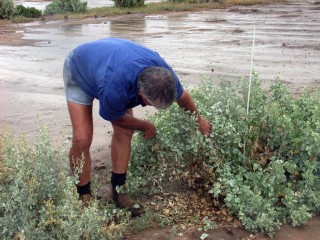 Southern Queensland landholders Rory and Kathy Frost have turned a long-term claypan into productive land that is now growing cattle feed with a complete cover of grass.
Southern Queensland landholders Rory and Kathy Frost have turned a long-term claypan into productive land that is now growing cattle feed with a complete cover of grass.
The Frosts run a mixed cattle and sheep farming enterprise near Yelarbon on the Queensland/New South Wales border.
Over the past five years they have used their understanding of carbon flows to regenerate a claypan that used to be bare, even in normal years, into country that is now carrying total groundcover of grass.
While the changes have coincided with a recent run of wet years, they cannot be explained away simply by seasonal factors. Were that the case, similar outcomes would have been achieved in wet years of the past. A longer run of high rainfall years in the 1970s produced no such changes in the same claypan.
The story of how the Frosts have regenerated a long-term degraded area offers not only thought-provoking practical messages for other landholders, but interesting insights into the basics of how landscapes function and potentially valuable implications for ongoing extension programs.
Go with the carbon flow
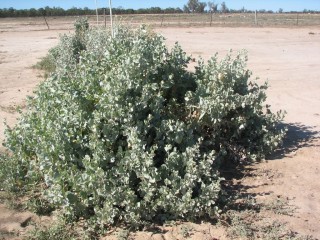 Pictures taken over a five year period on the Frost’s property document the step-by-step process of regeneration that has occurred across their claypan.
Pictures taken over a five year period on the Frost’s property document the step-by-step process of regeneration that has occurred across their claypan.
Rory says the changes were achieved by focusing on work to initiate “carbon flows” in the area, to activate the processes upon which healthy and productive paddocks rely.
He likened the process of repairing a claypan to rehabilitating a former mine site.
In each case the starting point is a near lifeless landscape which is slowly brought back to life below and above the ground by managing the flow of carbon.
“The natural world can’t function without carbon flows,” he explains.
“Soil life, grasses and herbages all rely on carbon flows to exist. Energy, nutrients and water all follow carbon – this is the fundamental basis of all life on the planet.”
To repair the claypan, Rory and Kathy said they had to work out how to get carbon flowing into the degraded area again.
Rory explains that was something of a catch 22 situation.
The claypan badly needed plants to ensure short-term carbon flowed in from the atmosphere via the plants to feed soil life and supply it with energy. The soil life would then restructure the soil and make it healthy and fertile again.
However, no perennial plants could establish from seed on the claypan to kick-start the ongoing carbon flows required for a healthy and productive landscape. Water was not getting into the soil to let plants establish. The picture at the top of this page shows water shedding on the claypan after just 1mm of rain.
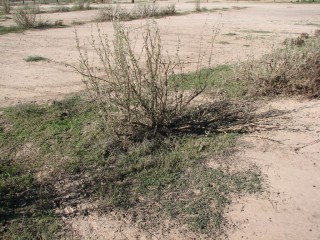 Kathy recalls that when they bought the property, they were not sure what they could do with the claypan. It was a daunting task, given it had been there for at least the 30 years that their next-door neighbour had lived in the area.
Kathy recalls that when they bought the property, they were not sure what they could do with the claypan. It was a daunting task, given it had been there for at least the 30 years that their next-door neighbour had lived in the area.
Native perennial kick-starts carbon cycle
Then they learned about the role that old man saltbush, a perennial deep-rooted shrub capable of establishing in harsh, claypan-like conditions, could play in regenerating such areas if planted as seedlings.
They purchased and planted bare-rooted saltbush seedlings in 2007 (see year one picture).
They said the seedlings effectively started the regeneration process by cycling carbon in their immediate vicinity.
The carbon compounds deposited by the saltbush on the soil surface in the form of litter (see picture with Rory Frost at top of page), and all of the different carbon compounds introduced below ground by the shrubs, supplied energy and a food source to allow soil life to return.
Cracking up
Kathy and Rory could see that the soil life was changing their soil structure for the better when they noticed the soil cracking near the saltbush about two years after it was planted. The cracking was a sign that the soil structure of the claypan was starting to change dramatically.
As water entry increased, the carbon flows also increased because other plants were able to germinate in the improved soil near the saltbush (see year two picture above).
The claypan continued to repair progressively further away from the saltbush as other plants kept entering on the edge of repaired areas (as illustrated in the year three picture below).
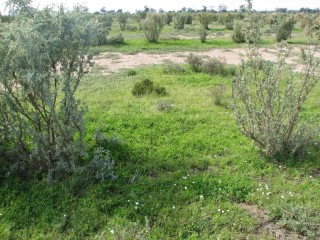 By this stage, other plants had taken over from the saltbush as the repair agent.
By this stage, other plants had taken over from the saltbush as the repair agent.
It is the same principle at play when normal paddocks remain productive, when management allows plants to grow after rain and maintain the flow of carbon compounds cycling through the paddock.
By year five, all of the soil had improved to the extent that perennial grasses now had an environment suitable for their establishment.
In the year two picture, couch was the only grass present. At year three the bulk of the claypan was still not favourable for perennial grass establishment.
Grass roots change
Another anecdote illustrates the changes that have occurred.
In the first year, not long after the saltbush was planted, Rory attempted to conduct a soil test on the claypan using a mechanical soil sampling unit on the back of a trayback. He could not complete the test because the soil was so hard it bent the sampling rod.
Five years later, the roots of perennial grasses are now able to penetrate the same soil.
This serves as testament to how nature utilises carbon flows to keep soil soft and to maintain productivity.
The claypan between the saltbush rows was not ripped at any stage.
Natural fertility increases
Kathy Frost says the decision to plant the saltbush has provided further benefits, because, without that intervention, more of the claypan would have blown and washed away, and the erosion would have ended up in the nearby Dumaresq river.
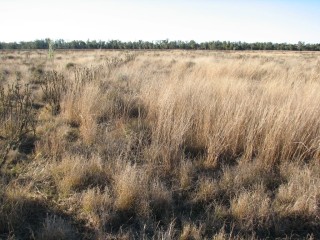 Kathy said dysfunctional landscapes became increasingly infertile with time, because they had a low potential for capturing new resources.
Kathy said dysfunctional landscapes became increasingly infertile with time, because they had a low potential for capturing new resources.
In support of this point, Rory said that animal manure dropped on the claypan had helped the regeneration process, as it washed across the claypan and penetrated the soil in the areas where vegetation was establishing.
No applications of fertiliser have been provided during the five year period. Following the reintroduction of carbon flows, the landscape has effectively been able to capture the resources it requires.
The year three photo was taken at the end of winter 2010. The prolific clover which has followed the improvement in water penetration has also played a role in increasing the soil fertility, which in turn has helped the perennial grasses to establish.
Perpetual drought to efficient rainfall conversion
The claypan drops slightly towards the west. The general pattern was initially for regeneration to spread east, towards the direction from which the water came.
As water ran across the claypan, it entered the soil when it reached the first of the vegetation.
The first two years saw well below average rainfall. In effect, on most occasions when rain fell, there was not enough water to get to the downside of the saltbush rows.
Rory said the claypan had previously been in a continual state of drought, regardless of how much rain fell.
This highlighted the correlation between water use efficiency (WUE) and prior carbon flows.
WUE is a measure of how successfully a production system converts water molecules into carbon molecules (ie the level of plant growth from supplied water).
Improved WUE is a recognised driver of profit in the grazing industry.
For the Frosts, the regenerated claypan is now contributing to profit as it is now able to convert rainwater into groundcover for livestock to eat.
“Wick effect” enables water penetration
As part of the regeneration process, the saltbush roots supplied a “wick effect” by allowing rain to go deeper into the soil by running down beside the roots. As other plants entered, their roots continued the wick effect across the claypan.
The depth that grass roots penetrate the soil is determined by the flow of carbon available to build the roots (roots are about 45 percent carbon when dried).
Rory said he developed his current understanding of the importance of carbon flows five years ago from Alan Lauder, the founder of the Carbon Grazing principle. The Carbon Grazing principle focuses on the role of carbon flows and how to maximise them.
“It was after discussions with Alan that I came to understand how carbon flows organised so many important processes that occur in the paddock,” Rory said.
“Given that cattle are about 18pc carbon and rely on the energy transported by carbon to grow, it is easy to see the linkage between my bottom line and how successfully carbon flows are managed.
“Soil life utilises carbon flows to release phosphorus and make it available to plants.”
RELATED ARTICLE: How understanding of carbon flows led to improved extension outcomes
Click on above related article for a summary of carbon stocks and carbon flows, how they relate to rural production and Rory and Kathy Frosts’ perspective as producers on how learning about the concept of carbon flows has enhanced their understanding of related extension activities.
Click on below images to view each stage of the regeneration process.
